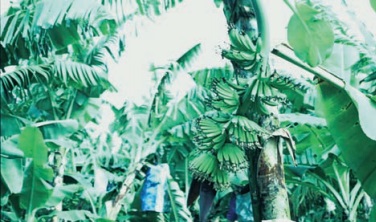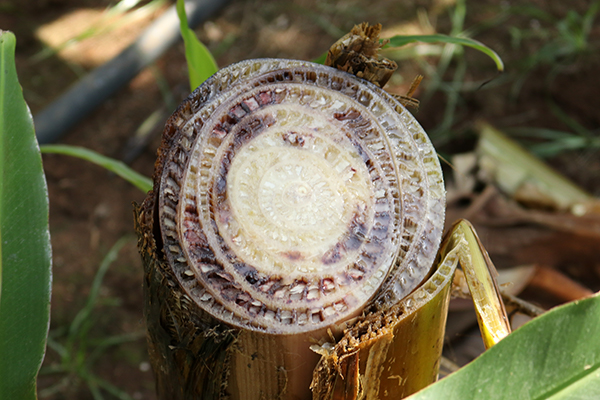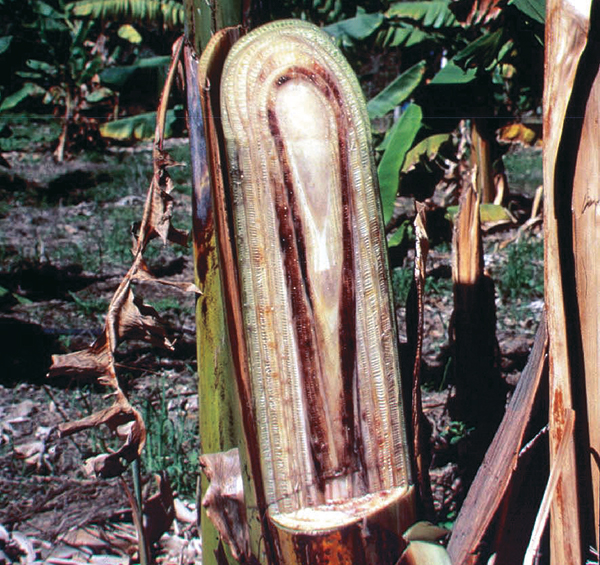Stages of leaf spot disease
Stages of leaf spot disease
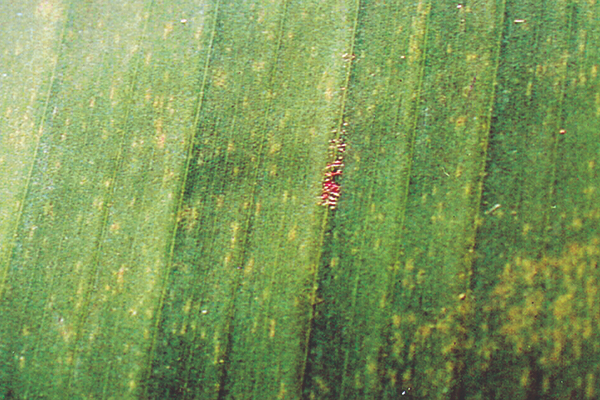
Stage 1 (speck/dot)
Yellowish green specks less than 1 mm long.
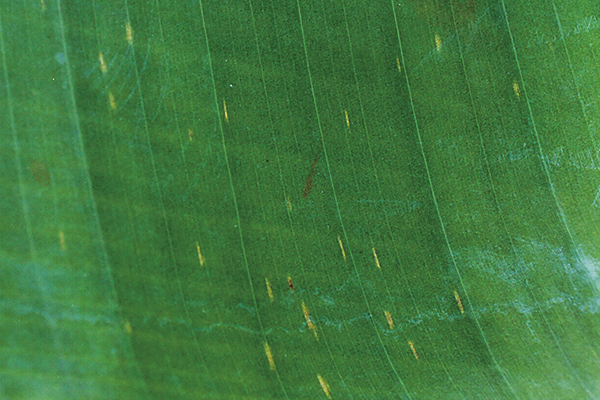
Stage 2a (early streak)
Specks become 3 to 4 mm x 1 mm long streaks, increase in length and turn yellowish.

Stage 2b (late streak)
Streaks darken to a rusty brown.
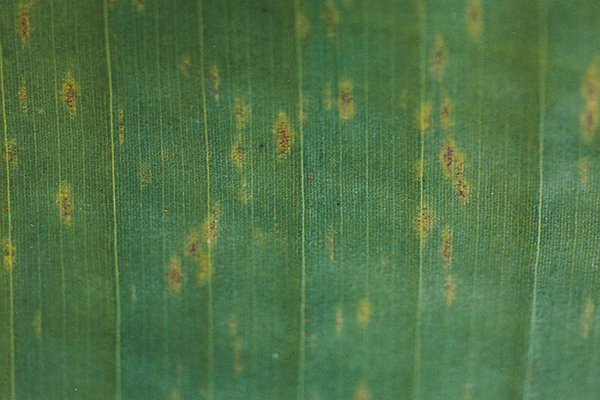
Stage 3 (early spot)
Streaks broaden to a spot. They become longer and wider, with indefinite margins, which may be water-soaked in appearance and darken to brown.
ns
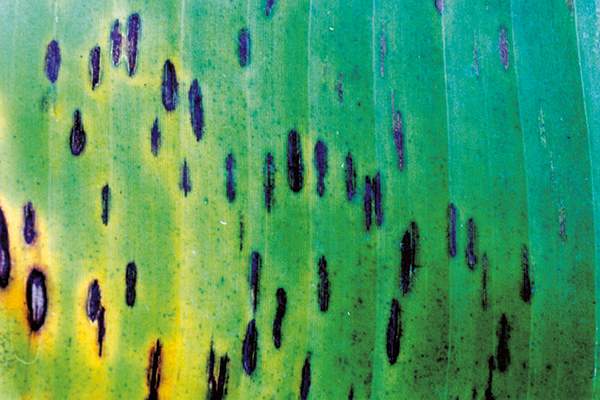
Stage 4 (Brown spot)
Spots have definite dark brown edges, the centre becomes sunken and is sometimes surrounded with a yellow halo. Conidia are produced on the surface.

Stage 5 (mature spot)
The sunken centre of spots turns grey and is surrounded by a dark brown to black border, sometimes with a yellow halo. Ascospores are produced within the grey central area of the mature spots.
ns
Corm smelly, rotting or discoloured
Corm smelly, rotting or discoloured
Panama disease (Fusarium wilt) (discoloured)
Biosecurity Alert
Cause: The fungus Fusarium oxysporum f. sp. cubense which is a soil-borne organism. It is spread in water, soil and planting material. It enters the plant through the roots, and blocks the conducting tissue within the plant resulting in wilting, yellowing of leaves, splitting of pseudostem and death of the plant.
Solution: There is no cure for affected plants. Use only approved planting material and do not plant in previously infested areas.
Biosecurity obligation: Panama is a notifiable disease and you must report any suspicious plants. If you suspect Panama disease you must notify Biosecurity Queensland immediately (13 25 23).
More info:

Bacterial corm rot (smelly, rotting, discoloured)
Cause: The bacteria Pectobacterium spp. (formerly known as Erwinia spp.) that are common soil inhabitants. Plants that are stressed during the dry season can succumb to invasion during the wet season.
Solution: No chemical treatments are available. Ensure adequate moisture levels are maintained during the dry season and provide good drainage during prolonged wet seasons.
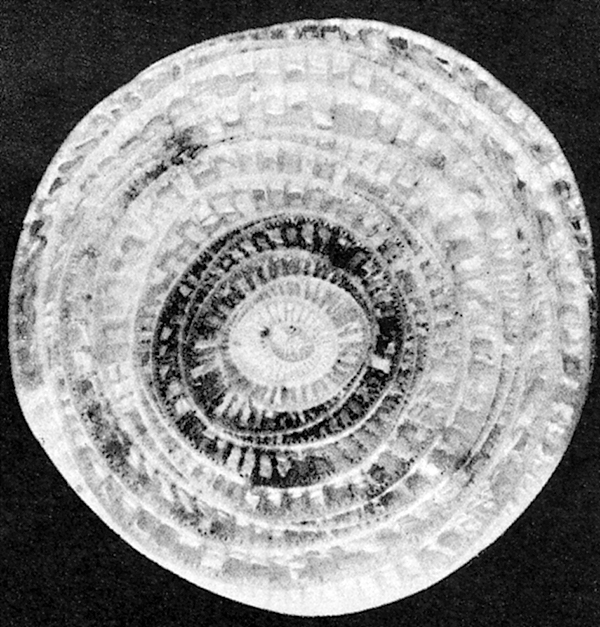
Moko disease (discoloured)
Biosecurity Alert
Cause: The bacteria Ralstonia solancearum race 2. Moko is a soil-borne disease and is spread with soil, in water, on implements, in planting material and by insects from flower to flower. The infection enters the plant through the roots and spreads through the host, blocking conducting tissue and resulting in plant yellowing, wilting and death.
Solution: There is no chemical control for Moko. All plants plus an adequate buffer zone around the diseased plants must be destroyed. The area must be quarantined and only non-host plants grown.
Biosecurity obligation: If you suspect Moko disease you must notify Biosecurity Queensland immediately (13 25 23).
More info:
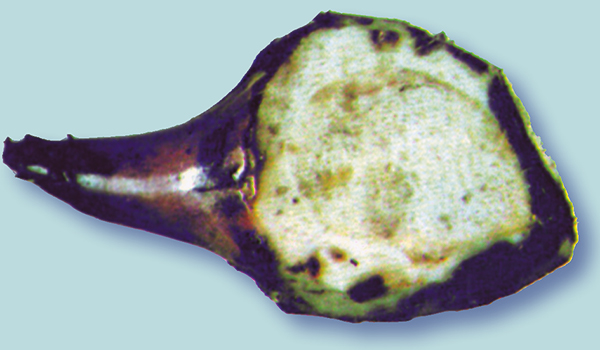
Burrowing nematode (discoloured)
Cause: Burrowing nematode feeding in the banana corm. Planting nematode-infected corm pieces is the most common method of spread to new areas.
Solution: Do not use banana corms with visible signs of nematode damage as planting material.
Tunnelling in corm
Tunnnelling in corm

Banana weevil borer
Cause: Tunnelling by larvae of Cosmopolites sordidus.
Solution: Use stem baits to establish the severity of the infestation. If necessary treat with an appropriate chemical. Follow label directions regarding application method and timing to maximise the effectiveness of the treatment.
Roots on soil surface
Roots on soil surface
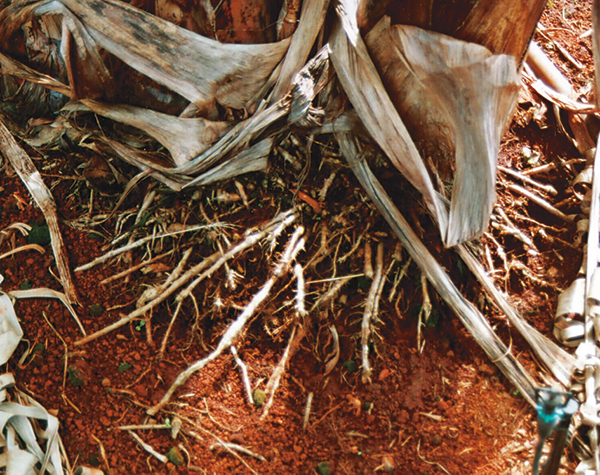
Water-logging
Cause: Soil erosion or too much water in the soil from rainfall or irrigation.
Solution: Avoid planting in wet areas and heavy soils. Install and maintain a drainage system for your plantation.
Roots discoloured internally
Roots discoloured internally
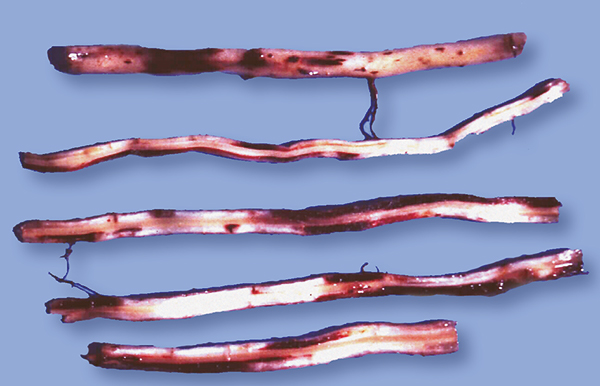
Burrowing nematode, other nematodes
Cause: Burrowing nematode Radopholus similis feeding on the cells in the root cortex. Many species of nematodes in the soil also parasitise the roots of bananas.
Solution: Nematodes other than burrowing nematode are not usually a problem in the tropics. Check a random sample of roots over the whole field to determine the extent of the problem and if a nematicide treatment is necessary.
Damaged roots or no root hairs
Damaged roots or no root hairs
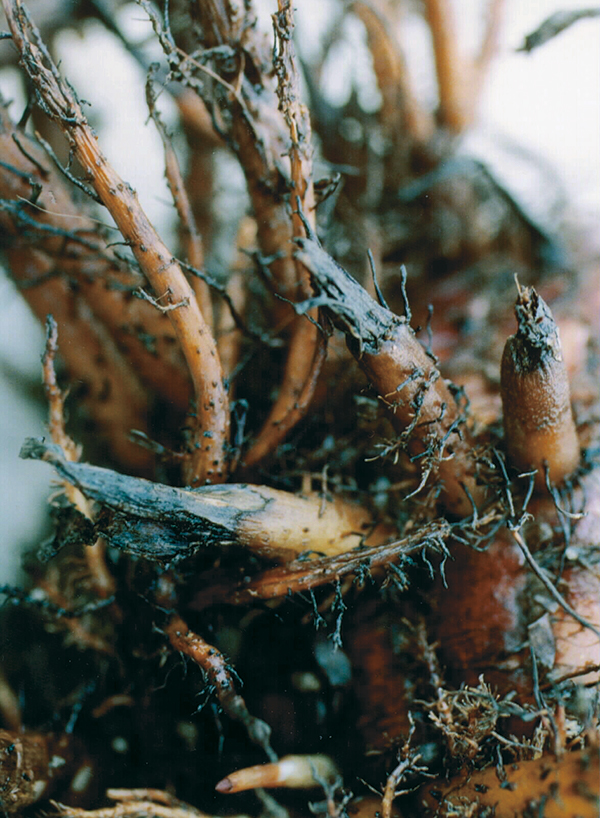
Fertiliser burn, drought or water-logging, poor drainage, air burn, soil compaction.
Cause: There are several causes of root tip burn. They include fertiliser burn from too much fertiliser or poor placement; aluminium or manganese toxicity caused by low soil pH; and soil drying out or staying too wet for too long. As well as these causes, air burn or soil compaction can cause root hairs to be lost.
Solution: Determine the cause with soil and tissue analyses. Broadcast fertiliser evenly and at recommended rates. Watering heavily to leach salts out of the root zone can alleviate problems of excess fertiliser. Maintain soil pH between 5 and 6 and avoid planting in areas with poorly drained soils.

Greyback cane beetle
Cause: Chewing by larvae (cane grubs) of Dermolepida albohirtum.
Solution: Correct timing of insecticide application is crucial. The chemical must be applied when larvae are close to the surface between November and January.
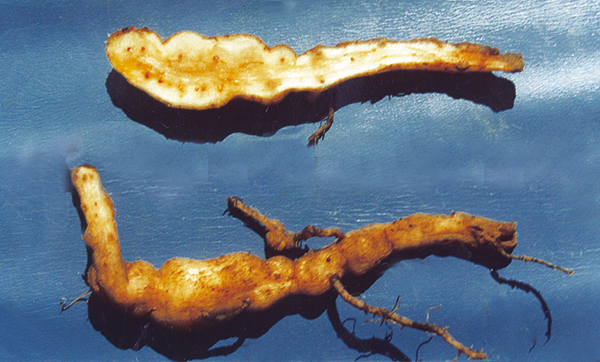
Root-knot nematode
Cause: Meloidogyne spp. Root-knot nematode invades the root when young. When mature the females form special feeding cells that appear as galls within the roots.
Solution: Root-knot nematode is not usually an economic problem to banana production in the tropics. Most mature banana plants with adequate irrigation and fertilising can compensate for any damage. Root-knot nematode may become a problem in very young plants, or on very sandy soils.
Leaves bunching at top of plant
Leaves bunching at top of plant
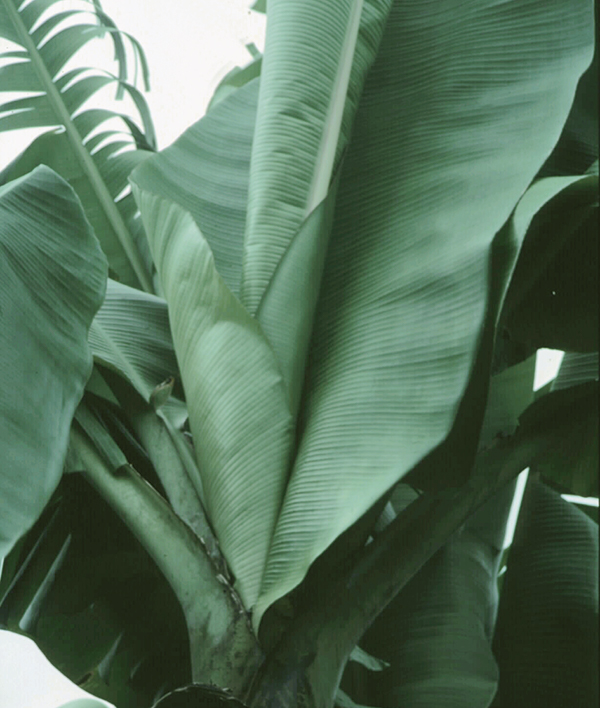
Choking of leaves
Cause: Choking can be due to a genetic abnormality related to a particular variety or off-type, or from stresses (water-logging, cold, water or nutrient shortage, 2,4-D, banana streak virus and bunchy top). These causes limit the normal elongation of the true stem so that the leaves appear ‘bunched up’.
Solution: Choose varieties less prone to choking and cull tissue-cultured off-types showing these symptoms. Check for diagnostic virus indicators. Improve management to limit stresses on plant.
Green leaves dropping
Green leaves dropping
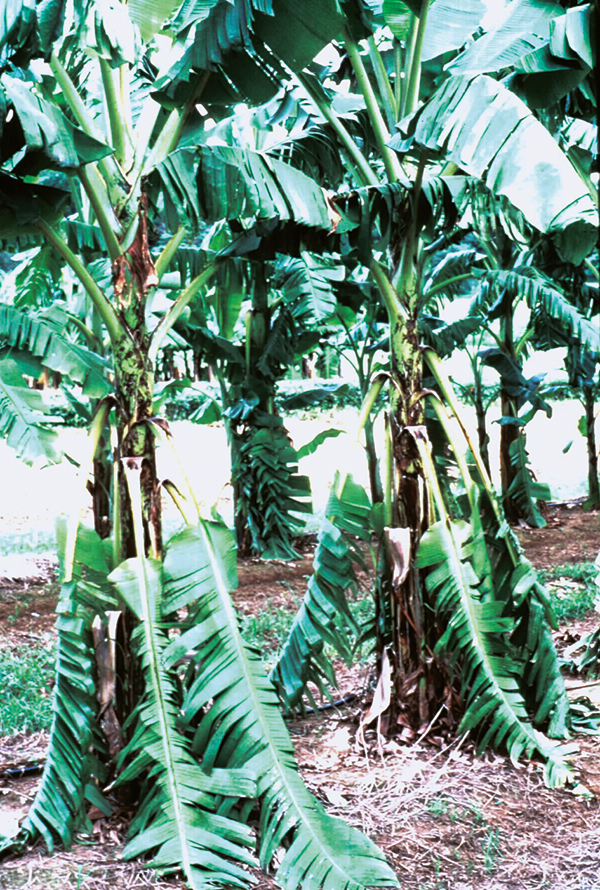
Panama disease (Fusarium wilt)
Biosecurity Alert
Cause: The fungus Fusarium oxysporum f. sp. cubense which is a soil-borne organism. It is spread in water, soil and planting material. It enters the plant through the roots, and blocks the conducting tissue within the plant resulting in wilting, yellowing of leaves, splitting of pseudostem and death of the plant.
Solution: There is no cure for affected plants. Use only approved planting material and do not plant in previously infested areas.
Biosecurity obligation: Panama is a notifiable disease and you must report any suspicious plants. If you suspect Panama disease you must notify Biosecurity Queensland immediately (13 25 23).
More info:
Bacterial corm rot
Cause: The bacteria Pectobacterium spp (formerly known as Erwinia spp.) are widespread in most soils. Plants that are stressed from heat or lack of water during the dry season can succumb to bacterial invasion during the early part of the wet season.
Solution: No chemical treatments are available. Ensure adequate moisture levels are maintained during the dry season and provide good drainage during prolonged wet seasons.
Water stress
Cause: Mild water stress during periods of high evaporation.
Solution: Apply more water during periods of high demand.
Internal stem discolouration
Internal stem discolouration
Panama disease (Fusarium wilt)
Biosecurity Alert
Cause: The fungus Fusarium oxysporum f. sp. cubense which is a soil-borne organism. It is spread in water, soil and planting material. It enters the plant through the roots, and blocks the conducting tissue within the plant resulting in wilting, yellowing of leaves, splitting of the pseudostem and death of the plant.
Solution: There is no cure for affected plants. Use only approved planting material and do not plant in previously infested areas.
Biosecurity obligation: Panama is a notifiable disease and you must report any suspicious plants. If you suspect Panama disease you must notify Biosecurity Queensland immediately (13 25 23).
More info:


